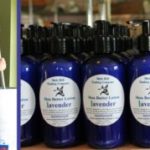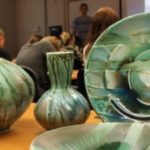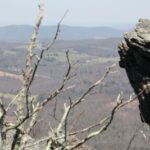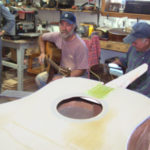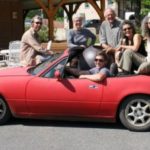The Soap Lady
Contributed by Emily Dix and Tanner Jackson
Way back 15 miles in the country, near Wytheville, Virginia, there is a small, green, block building that will take you back in time 50 years. This is where Crystal Gillian makes her craft at Mule Hell Trading Company.
Our class at Wytheville Community College’s Appalachian Governor’s School took a trip there one crisp summer morning, to a place called Cripple Creek, Virginia. As we pulled up, as soon as we got off the bus, we could smell the strong scent of the soaps. As we walked through the door, we saw a small black-haired lady, standing on a stool stirring soap.
We could look around and see that she is very dedicated to her craft. She has over 60 products ranging from soaps to lip balms and everything in between. As we walked through the store we could easily smell the variety of soaps . . . my favorite was Milk and Honey.
We were wondering where the name Mule Hell came from. It is the name of the road where her grandmother’s house stands, which is where she lives now, and the road about two miles away from her Company. Her grandmother made soaps when Crystal was younger, but Crystal never tried to make it herself until she was 22.
When Crystal moved away from southwest Virginia, she transferred into the modern world of London, and the city-life. She married and had a child. She had many jobs but none of them ever worked out. When she moved back to Virginia, she moved into her grandmother’s 140 year old house and found the tools her grandmother used to make her soap. She also found bars of soap that were 50 years old and were still useable.
The soap interested her so that she decided she would learn how to make it. She had no help, only books and her small memories of her grandmother. When Crystal first tried to make a bar of soap, it did not work out for her. It took her three tries to finally get it right. In 2010, she started making soap to sell, but she didn’t know if that would be enough to make a living so she did other things such as work at a greenhouse and a community garden.
Her soap business took off faster than anything else and she couldn’t supply enough for the demand. She stopped doing the garden and the greenhouse and spent her time solely making soap in her house. The inventory was overwhelming and she didn’t have enough space. In 2011, she took out a loan and bought an old store, restored it and established her own company. Within three years, she has grossed over $120,000 dollars and her company continues to grow.
She has her products in many local stores and sales her soaps at festivals in southwest Virginia. If you would like to visit her, then take a trip around a curvy road surrounded by farm lands and experience the culture and the true heritage of her lifestyle. Her shop is located at 134 Francis Mill Road in Cripple Creek, VA. If you would like to contact Ms. Gillian you can email her at crystalgillian@embraqmail.com, visit her Facebook page at Mule Hell Trading Co. or you can ‘give her a holler’ at 276-621-4741.
Unexpected Art from an Unexpected Artist
Walking My Mountains to Prepare to Walk the Camino de Santiago
 The founder of Taoism, Lao-tzu, is attributed with saying “The longest journey begins with a single step.” My journey began around 2000 when I was first introduced to the Camino de Santiago by Shirley Maclaine’s book, The Camino. I was intrigued by her accounts of a self-discovery pilgrimage.
Maclaine wasn’t the first person to travel that Pilgrimage and I won’t be the last. For the last 1000 years, people such as St. Francis of Assisi, Charlemagne, Ferdinand and Isabella, Dante and even Chaucer have taken the journey.
Most people walk the distance in 28 to 42 days. I will be taking my time and staying at least 40 days.
I’ve asked myself several times, “Why am I so interested in walking 500 miles, alone, in a country 4,000 miles away from home?” My Spanish is nonexistent. Almost 50 years ago, I had one year of Spanish in high school.
I’ve always been fascinated with other cultures and travel. I’ve fed that attraction with many trips to numerous countries. I’ve hosted people from several counties and have been a guest of others in foreign lands.
A vivid memory from my early childhood was my owning a book titled The Wanderlust. I don’t know how I acquired it and I don’t remember the plot. I’ve searched on-line, hoping to find a clue to the allure, but haven’t found anything that resembles that particular book.
Why? Could it be something about Maya Angelou’s passage?“Perhaps travel cannot prevent bigotry, but by demonstrating that all peoples cry, laugh, eat, worry, and die, it can introduce the idea that if we try and understand each other, we may even become friends.”
Traditionally, as with most pilgrimages, the Way of Saint James or the Camino de Santiago, begins at home and ends at the final destination site. To me, a pilgrimage is more than just the miles one walks on the actual route. I can attest to the fact that the journey begins at conception by the 8 months I have spent, and the 3 months more that I need, to get ready for this walk; not counting the years that the seed has been germinating in my heart and head. It has already been a journey in and of itself; just the soul-searching alone could be termed a pilgrimage.
I’ve given hours and hours to internet searches and I’ve read several books, including A Pilgrims Guide to The Camino de Santiago by John Brierley, To Walk Far, Carry Less by Jean-Christie Ashmore, Eyewitness Travel ‘s Northern Spain, and one book that was so boring I gave it away and don’t remember the name or author. When The Waycame out, a 2010 American film with Emilio Estevez and his father Martin Sheen, I was beside myself with excitement. It was such a small budget, small release film that I missed it in the theatres, but was so happy to buy it on DVD two years ago.
My tickets to Spain, in early May, are ready and waiting. I have a reservation for a two-night stay at a hotel when I arrive in Pamplona, known here for Hemingway and the Running of the Bulls. I’ll need to get over jetlag and I want some time to see the city before I set out on foot.
I’ve gone against my frugal nature of walking around town, several days a week, and have joined the Carroll Wellness Center. I need upper-body strength to carry a 20-pound backpack and have it less burdensome. I’ve followed all the sales at REI and made three trips to Greensboro, the nearest REI store, to reequip my hiking supplies. My boots are 20 years old and the sole is about to come off. Five-hundred miles with less than wonderful hiking boots-I don’t think so!
The main pilgrimage route to Santiago, since the Middle Ages, follows an earlier Roman trade route. There are more than a dozen routes that converge at Saint James’ tomb in western Spain. Many people walk the Way for religious reasons. Many hikers walk the route for non-religious reasons such as travel, sport, or the challenge. Part of my fascination and determination is to experience a spiritual adventure and to distance myself from the hustle and bustle of everyday life. Part of my resolve is to stay as young as possible, both mentally and physically. This segment of my life should provide proof of my mental and physical competences, one way or the other.
The Camino’s accommodations are unique with pilgrim hostels (albergues) which allow pilgrims to sleep in dormitory-style accommodations for as little as €3-10 ($4-14) per night. A good reason to go in May is to avoid the college kids that frequent the trail in the summer months. By all accounts, there are pilgrims of all age groups. Pilgrim menus are served in restaurants and sometimes at the hostels and are reasonably priced to accommodate the cathartic adventure.
To prevent misuse of the 1000-year old spirit of hospitality at the refugios, a stayis limited to those carrying proof of their intentions. One small indication that a person is a perigrino (pilgrim) is the iconic symbol of the scallop shell carried by the traveler. There are many accounts as to why this item is symbolic, but one source suggests the grooves in the shell meet at a single point that represent the various routes traveled, arriving at a single destination: the tomb of James in Santiago de Compostela.
Authentic pilgrims carry a credencial, a pass which gives access to the inexpensive and sometimes free, accommodation. The credencial is stamped at each hostel along the way.
Once you reach the Santiago de Compostela Cathedral, after a ritual visit to Saint James’ tomb, you may present your credencial and petition for a compostela, a certificate of accomplishment, written in Latin, given to pilgrims completing the Way.
How will I feel after spending that many days away from family, away from the familiar? Will I want to take up where I leave off? Will my life ever be the same?
Follow my day-to-day experience as I blog about this journey at www.penelopesart.com. I will also carry a pencil and a beautiful new lightweight leather journal that my good friend gave me for the trip in which I will attempt to record my thoughts for later reflections.
The founder of Taoism, Lao-tzu, is attributed with saying “The longest journey begins with a single step.” My journey began around 2000 when I was first introduced to the Camino de Santiago by Shirley Maclaine’s book, The Camino. I was intrigued by her accounts of a self-discovery pilgrimage.
Maclaine wasn’t the first person to travel that Pilgrimage and I won’t be the last. For the last 1000 years, people such as St. Francis of Assisi, Charlemagne, Ferdinand and Isabella, Dante and even Chaucer have taken the journey.
Most people walk the distance in 28 to 42 days. I will be taking my time and staying at least 40 days.
I’ve asked myself several times, “Why am I so interested in walking 500 miles, alone, in a country 4,000 miles away from home?” My Spanish is nonexistent. Almost 50 years ago, I had one year of Spanish in high school.
I’ve always been fascinated with other cultures and travel. I’ve fed that attraction with many trips to numerous countries. I’ve hosted people from several counties and have been a guest of others in foreign lands.
A vivid memory from my early childhood was my owning a book titled The Wanderlust. I don’t know how I acquired it and I don’t remember the plot. I’ve searched on-line, hoping to find a clue to the allure, but haven’t found anything that resembles that particular book.
Why? Could it be something about Maya Angelou’s passage?“Perhaps travel cannot prevent bigotry, but by demonstrating that all peoples cry, laugh, eat, worry, and die, it can introduce the idea that if we try and understand each other, we may even become friends.”
Traditionally, as with most pilgrimages, the Way of Saint James or the Camino de Santiago, begins at home and ends at the final destination site. To me, a pilgrimage is more than just the miles one walks on the actual route. I can attest to the fact that the journey begins at conception by the 8 months I have spent, and the 3 months more that I need, to get ready for this walk; not counting the years that the seed has been germinating in my heart and head. It has already been a journey in and of itself; just the soul-searching alone could be termed a pilgrimage.
I’ve given hours and hours to internet searches and I’ve read several books, including A Pilgrims Guide to The Camino de Santiago by John Brierley, To Walk Far, Carry Less by Jean-Christie Ashmore, Eyewitness Travel ‘s Northern Spain, and one book that was so boring I gave it away and don’t remember the name or author. When The Waycame out, a 2010 American film with Emilio Estevez and his father Martin Sheen, I was beside myself with excitement. It was such a small budget, small release film that I missed it in the theatres, but was so happy to buy it on DVD two years ago.
My tickets to Spain, in early May, are ready and waiting. I have a reservation for a two-night stay at a hotel when I arrive in Pamplona, known here for Hemingway and the Running of the Bulls. I’ll need to get over jetlag and I want some time to see the city before I set out on foot.
I’ve gone against my frugal nature of walking around town, several days a week, and have joined the Carroll Wellness Center. I need upper-body strength to carry a 20-pound backpack and have it less burdensome. I’ve followed all the sales at REI and made three trips to Greensboro, the nearest REI store, to reequip my hiking supplies. My boots are 20 years old and the sole is about to come off. Five-hundred miles with less than wonderful hiking boots-I don’t think so!
The main pilgrimage route to Santiago, since the Middle Ages, follows an earlier Roman trade route. There are more than a dozen routes that converge at Saint James’ tomb in western Spain. Many people walk the Way for religious reasons. Many hikers walk the route for non-religious reasons such as travel, sport, or the challenge. Part of my fascination and determination is to experience a spiritual adventure and to distance myself from the hustle and bustle of everyday life. Part of my resolve is to stay as young as possible, both mentally and physically. This segment of my life should provide proof of my mental and physical competences, one way or the other.
The Camino’s accommodations are unique with pilgrim hostels (albergues) which allow pilgrims to sleep in dormitory-style accommodations for as little as €3-10 ($4-14) per night. A good reason to go in May is to avoid the college kids that frequent the trail in the summer months. By all accounts, there are pilgrims of all age groups. Pilgrim menus are served in restaurants and sometimes at the hostels and are reasonably priced to accommodate the cathartic adventure.
To prevent misuse of the 1000-year old spirit of hospitality at the refugios, a stayis limited to those carrying proof of their intentions. One small indication that a person is a perigrino (pilgrim) is the iconic symbol of the scallop shell carried by the traveler. There are many accounts as to why this item is symbolic, but one source suggests the grooves in the shell meet at a single point that represent the various routes traveled, arriving at a single destination: the tomb of James in Santiago de Compostela.
Authentic pilgrims carry a credencial, a pass which gives access to the inexpensive and sometimes free, accommodation. The credencial is stamped at each hostel along the way.
Once you reach the Santiago de Compostela Cathedral, after a ritual visit to Saint James’ tomb, you may present your credencial and petition for a compostela, a certificate of accomplishment, written in Latin, given to pilgrims completing the Way.
How will I feel after spending that many days away from family, away from the familiar? Will I want to take up where I leave off? Will my life ever be the same?
Follow my day-to-day experience as I blog about this journey at www.penelopesart.com. I will also carry a pencil and a beautiful new lightweight leather journal that my good friend gave me for the trip in which I will attempt to record my thoughts for later reflections.
Wayne Henderson & the Eric Clapton Guitar
16 Hands Studio Tour
 Contributed by Big Blue Author
Nestled in the hills around Floyd, Virginia is a group of craftsmen you might want to get to know: Ellen Shankin, Brad Warstler, Donna Polseno, Silvie Granatelli, Richard Hensley and Stacy Snyder.
The members of 16 Hands have been friends longer than any of them can remember. In 1998 they got together and started what has become a much-anticipated event in the region, The 16 Hands Studio Tour, occurring twice yearly. The tour features a wide variety of pottery and woodworking by artists who have distinguished themselves nationally.
These artists have gained notoriety throughout their careers through exhibitions, museum collections, stints teaching at art schools all across the country, and internationally, appearances in literally dozens of exquisite books and publications about American craft and winning 6 National Endowment of the Arts or Virginia Museum grants among them.
The next tour, May 2&3, 2009, has something for everyone. There are many reasons to check it out. If you simply want a good excuse to explore their corner of the Blue Ridge Mountains, or you collect pottery and woodworking and would like to peek into the world of the people who make objects that enrich your life, or maybe you just want an exciting new way to buy some unique gifts, you won’t be disappointed.
It has become common practice with 16Hands to invite artists from around the country to join them for the tour. “It is wonderful to get to know these creative people who join our tour for the weekend. We host them in our homes and enjoy the opportunity to talk shop and develop friendships. We get to spend a lot of time around their work, deeply experiencing the beauty of the pieces,” says Ellen.
For the visitor on the tour, it means a chance to see work that has not been exhibited in the region before and an ever changing display to view each time you go. This year their visiting artists are, Mark Shapiro and Sam Taylor who will be traveling down from Massachusetts, Allison McGowan will be coming up from Concord, NC, and Davin Butterfield, a founding member of 16 hands, who married and moved to upstate NY.
With a detailed map from their web site, www.16hands.com, you can wind your way along the scenic drives that connect the studios. Whether riding along the Blue Ridge Parkway or stopping beside the mile long stretch of the Little River, the views and vistas, the woods and meadows are a jump above the mall when it comes to shopping. And there is so much to do in the area. Excellent restaurants and fine B&Bs abound. The Crooked Road highlights a nationally recognized music scene in Floyd with the Friday Night Jamboree at the Country Store, an experience not to be missed.
Contributed by Big Blue Author
Nestled in the hills around Floyd, Virginia is a group of craftsmen you might want to get to know: Ellen Shankin, Brad Warstler, Donna Polseno, Silvie Granatelli, Richard Hensley and Stacy Snyder.
The members of 16 Hands have been friends longer than any of them can remember. In 1998 they got together and started what has become a much-anticipated event in the region, The 16 Hands Studio Tour, occurring twice yearly. The tour features a wide variety of pottery and woodworking by artists who have distinguished themselves nationally.
These artists have gained notoriety throughout their careers through exhibitions, museum collections, stints teaching at art schools all across the country, and internationally, appearances in literally dozens of exquisite books and publications about American craft and winning 6 National Endowment of the Arts or Virginia Museum grants among them.
The next tour, May 2&3, 2009, has something for everyone. There are many reasons to check it out. If you simply want a good excuse to explore their corner of the Blue Ridge Mountains, or you collect pottery and woodworking and would like to peek into the world of the people who make objects that enrich your life, or maybe you just want an exciting new way to buy some unique gifts, you won’t be disappointed.
It has become common practice with 16Hands to invite artists from around the country to join them for the tour. “It is wonderful to get to know these creative people who join our tour for the weekend. We host them in our homes and enjoy the opportunity to talk shop and develop friendships. We get to spend a lot of time around their work, deeply experiencing the beauty of the pieces,” says Ellen.
For the visitor on the tour, it means a chance to see work that has not been exhibited in the region before and an ever changing display to view each time you go. This year their visiting artists are, Mark Shapiro and Sam Taylor who will be traveling down from Massachusetts, Allison McGowan will be coming up from Concord, NC, and Davin Butterfield, a founding member of 16 hands, who married and moved to upstate NY.
With a detailed map from their web site, www.16hands.com, you can wind your way along the scenic drives that connect the studios. Whether riding along the Blue Ridge Parkway or stopping beside the mile long stretch of the Little River, the views and vistas, the woods and meadows are a jump above the mall when it comes to shopping. And there is so much to do in the area. Excellent restaurants and fine B&Bs abound. The Crooked Road highlights a nationally recognized music scene in Floyd with the Friday Night Jamboree at the Country Store, an experience not to be missed.
